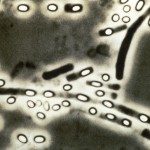Link to Pubmed [PMID] – 19785525
J. Infect. Dis. 2009 Nov;200(9):1381-9
BACKGROUND: The Bacillus anthracis poly-gamma-D-glutamate capsule is essential for virulence. It impedes phagocytosis and protects bacilli from the immune system, thus promoting systemic dissemination.
METHODS: To further define the virulence mechanisms brought into play by the capsule, we characterized the interactions between encapsulated nontoxinogenic B. anthracis and its host in vivo through histological analysis, perfusion, and competition experiments with purified capsule.
RESULTS: Clearance of encapsulated bacilli from the blood was rapid (>90% clearance within 5 min), with 75% of the bacteria being trapped in the liver. Competition experiments with purified capsule polyglutamate inhibited this interaction. At the septicemic phase of cutaneous infection with spores, the encapsulated bacilli were trapped in the vascular spaces of the liver and interacted closely with the liver endothelium in the sinusoids and terminal and portal veins. They often grow as microcolonies containing capsular material shed by the bacteria.
CONCLUSION: We show that, in addition to its inhibitory effect on the interaction with the immune system, the capsule surrounding B. anthracis plays an active role in mediating the trapping of the bacteria within the liver and may thus contribute to anthrax pathogenesis. Because other microorganisms produce polyglutamate, it may also represent a general mechanism of virulence or in vivo survival.



